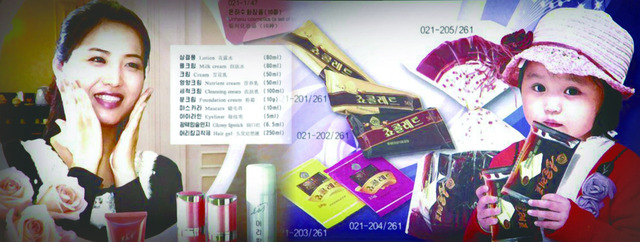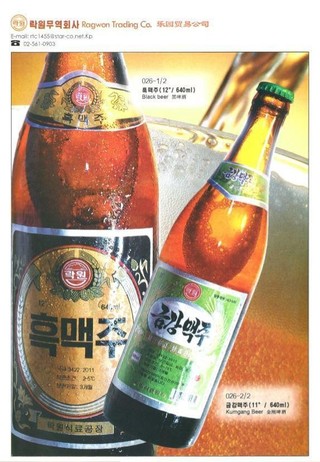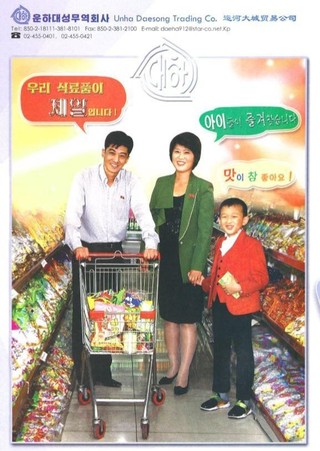 |
|
A pamphlet titled “Joseon Products 2018,” published by North Korea’s International Trade Promotion Committee, details North Korean advertisements for a variety of products, from cosmetics to beer.
|
Business owners rely on ads and compete with others in service and product quality
“There aren’t a lot of commercials on television yet and most of them tend to be for state-owned enterprises, but all kinds of companies and individually owned stores are advertising with posters. North Korea has really become a capitalist society. Buyers insist on good products and good services, and sellers have to advertise effectively if they want their products to sell and their profits to rise. Stores put out ads because they have to compete. When I was in Pyongyang, I ran a store, too, and I paid my staff to put up posters at the building entrance, on nearby utility poles and at the entrance to the market. Young people who visited the market came by when they saw my advertisements.”
This account was provided by a 20-something North Korean defector who left Pyongyang and came to South Korea last year. North Korea is being changed by advertisements, the “flowers of capitalism.” Considering that North Korea prides itself as being a society of “Juche socialism,” it should come as no surprise that commercial advertisements were long forbidden there. But since Kim Jong-un took over in 2012, there has been a rapid spread of commercial advertisements that entice North Koreans’ eyes and ears. Both companies and consumers are rapidly changing, driven by market trends.
North Korean customers getting pickier
 |
|
A beer ad by Rakwon General Trading Corporation
|
“Whether there’s a mountain or an ocean in the way [. . .] the image is always crisp” (a digital LED television ad by Paradise Technology Exchange Company)
“Lotion that prevents aging and brings you the vitality and beauty of youth” (a skincare ad by Joseon Sangwon Trading Company)
“The amazing ability to revive dead sperm!” (an erectile dysfunction medication ad by the Joseon Eastern Fast-Acting Pharmaceutical Development Firm)
These advertising slogans appeared in “Joseon Products 2018,” published by North Korea’s International Trade Promotion Committee. This pamphlet provides detailed information in Korean, English and Chinese about products produced by 43 North Korean companies.
The promotional pamphlet also includes customer testimonials. “I lost my appetite and had trouble eating, but this medicine brought my appetite back and has me feeling much better,” wrote a customer of Immune Rejuvenation-30. “I tried this medicine because of numbness in my extremities and pain in my joints. Now the pain is all gone, and I can even climb steep staircases without any issues,” reported a customer of Youth Capsules for Old Age.
The supply-oriented mentality that is characteristic of socialist economies had long been engrained in North Korean companies, but this shows that they’re adapting to more recent changes. If they want to sell more products, these companies have to communicate with their customers and pay attention to their preferences.
In the summer of 2018, North Korean leader Kim Jong-un and his wife Ri Sol-ju visited the Shinuiju Cosmetics Factory, which puts out a popular cosmetic product called Spring Fragrance. “Don’t get complacent just because there’s high demand and people love your products. You need to find ways to make your products stand out,” Kim was quoted as saying by the Rodong Sinmun. Essentially, Kim’s advice was to respect the taste and preferences of pickier North Korean consumers.
“Since Kim Jong-un came to power, there’s been a growing sense that the priority should be placed on the people’s livelihood. The emphasis on the public livelihood can be understood as an attempt to reconfigure the industrial structure from its original focus on heavy industries to consumer goods,” said Jeon Yeong-seon, a professor at Konkuk University.
Advertisements evolving both in format and content
 |
|
A snack ad by Unha Daesong Trading Company
|
A 30-year-old North Korean defector, who pays attention to changes in North Korea, was recently shocked to see the variety of advertisements for products in the North. “Until recently, advertisements in North Korea were rather limited, amounting to black-and-white text along the lines of ‘such-and-such beauty parlor’ in one section of the newspaper. Now, though, the ads are getting more sophisticated, with images added to posters and more attention-grabbing colors and fonts,” he said.
“It’s amazing to see ads even for things like a karaoke amplifier. A range of new products have been released, such as flat LED televisions and Bluetooth earphones, which seems to have resulted in the production of quite a few ads. There are tons of Chinese products in North Korea, and I guess the North Koreans are putting so much energy into their ads out of concern that their products will lose out,” the 20-something North Korean said.
Even a North Korean from North Hamgyong Province who defected to the South in 2016 is amazed by the current situation in the North. “In 2015, I saw new products like medication and the Arirang mobile phone being introduced on the TV news, but they weren’t ads. When you went to the cosmetics market, your only option was what the salesperson showed you, and if they said something was popular, that was all the information you had to go on. The ads coming out these days for cosmetics and laptop computers are so fresh,” he said.
In fact, North Korea’s journal Economic Research recently published an article titled “Principles for Engaging in the Product Advertisement Business” in its second 2018 issue. During the rule of Kim Il-sung and Kim Jong-il, it would have been hard to imagine a journal that’s supposed to be discussing the “Juche economy” instead publishing an article about how to advertise effectively.
“When you draw up your product ad, don’t assume it will last you for 10 or 20 years; you need to constantly find distinctive ways to update your products,” the article said.
“It’s a big change for North Korean companies to be making an effort to aggressively sell their products to consumers through glitzy and eye-grabbing packaging and advertisements,” said Hong Min, head of North Korean research at the Korea Institute for National Unification.
“At first, North Korea ran ads in an attempt to show the outside world that ‘North Korea has ads, too.’ The second stage saw the appearance of ads designed to earn foreign currency and attract tourists. The third stage is advertisements aimed at the North Korean public, which began about two years ago and took off in 2018,” said Ju Seung-hyeon, a North Korean defector and professor at Incheon National University who studies North Korean society and the division of the peninsula.
“Prior to this, the very concept of advertising was something that was unimaginable in North Korea. North Koreans regard the new experience of ads as a symbol of hope, that life will get better and that they have a future. Since this is a change that took place since Kim Jong-un came to power, it raises our expectations about him, too.”
The gradual diversification of commercial advertisements in North Korea demonstrates that the market in the country is growing rapidly. Yang Mun-su, a professor at the University of North Korean Studies said that ads are “a barometer of marketization, reform and opening in North Korea.”
Ads on TV and in the streets
There are also more commercials in TV programming, which has been a key method of socialist propaganda and indoctrination. After the news is over, 30-second commercials are played for two or three products, consisting of stationary images with background music. There are a lot of commercials about everyday consumer goods, including traditional medicine, cosmetics and foodstuffs, as well as relatively more expensive consumer electronics, such as televisions. This suggests that North Koreans’ purchasing power is growing. Change can also be seen in the 5-10 minute documentary-style commercials that involve visits to factories or corporate offices: political and ideological propaganda for the regime has given way to product quality and customer experiences and testimonials.
In a May 2018 report titled “The Current State and Implications of Television Commercial Utilization in North Korea,” Kim Min-gwan, deputy director of the unification project department for the Korea Development Bank (KOB), analyzed TV commercials that ran on North Korean media outlet DPRK Today.
“A large percentage of the commercials represented food and beverages, including the Daedong River Total Fruit Processing Factory and Rakyon Food Product Factory, and retail, including the Ryomong Street Store and Bongnam Tailor’s. The service industry, represented by Ryugyong Rose Garden (entertainment), Mirim Equestrian Riding Club (entertainment) and Air Koryo (transportation), also accounted for a large share of commercials,” Kim wrote in his report. Kim calculated that 53 of the TV commercials that ran on DPRK Today between July 2017 and May 2018 were in the news format and 20 were in the documentary format.
Commercial advertisements are also gradually appearing more often on the streets of Pyongyang, known as the “capital of the revolution.” During an international marathon that was held in Pyongyang in Apr. 2016, ads for the sponsor were on display. Koryo Ginseng Company put up posters around the venue, wrote its company name on uniforms alongside the contestants’ numbers and handed out samples of ginseng drinks during the event. Ads are also displayed on screens installed in Pyongyang subway stations, experts say.
That said, the paper in Economic Research described North Korea’s advertisements as “a commercial service that lets people know what products are good for, how they are used and how they can be purchased” and contended that these ads are different from their capitalist counterparts, which “may be flashy on the outside but often have little to do with the people’s lifestyle.” This suggests that North Koreans may be torn between the official ideology of a socialist economy and the new reality of the market economy.
By Noh Ji-won and Park Min-hee, staff reporters
Please direct comments or questions to [english@hani.co.kr]











